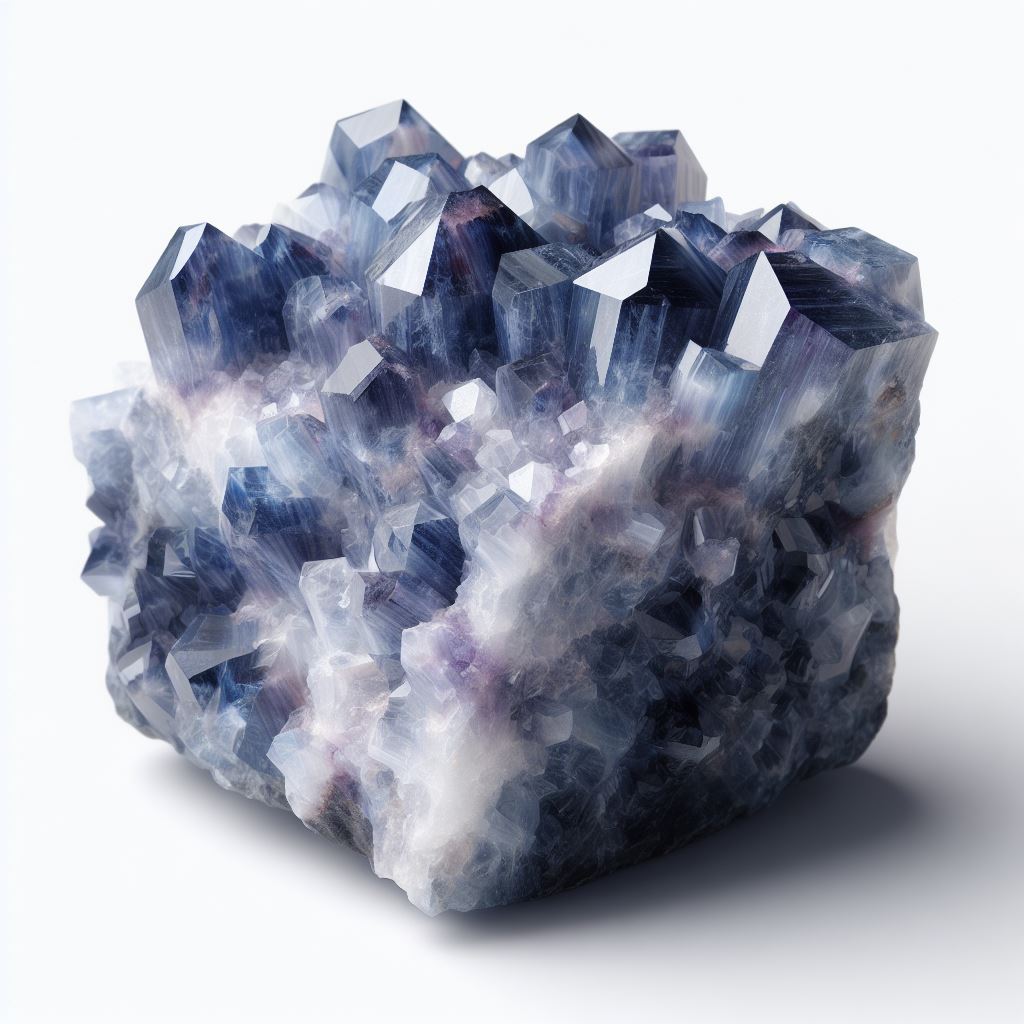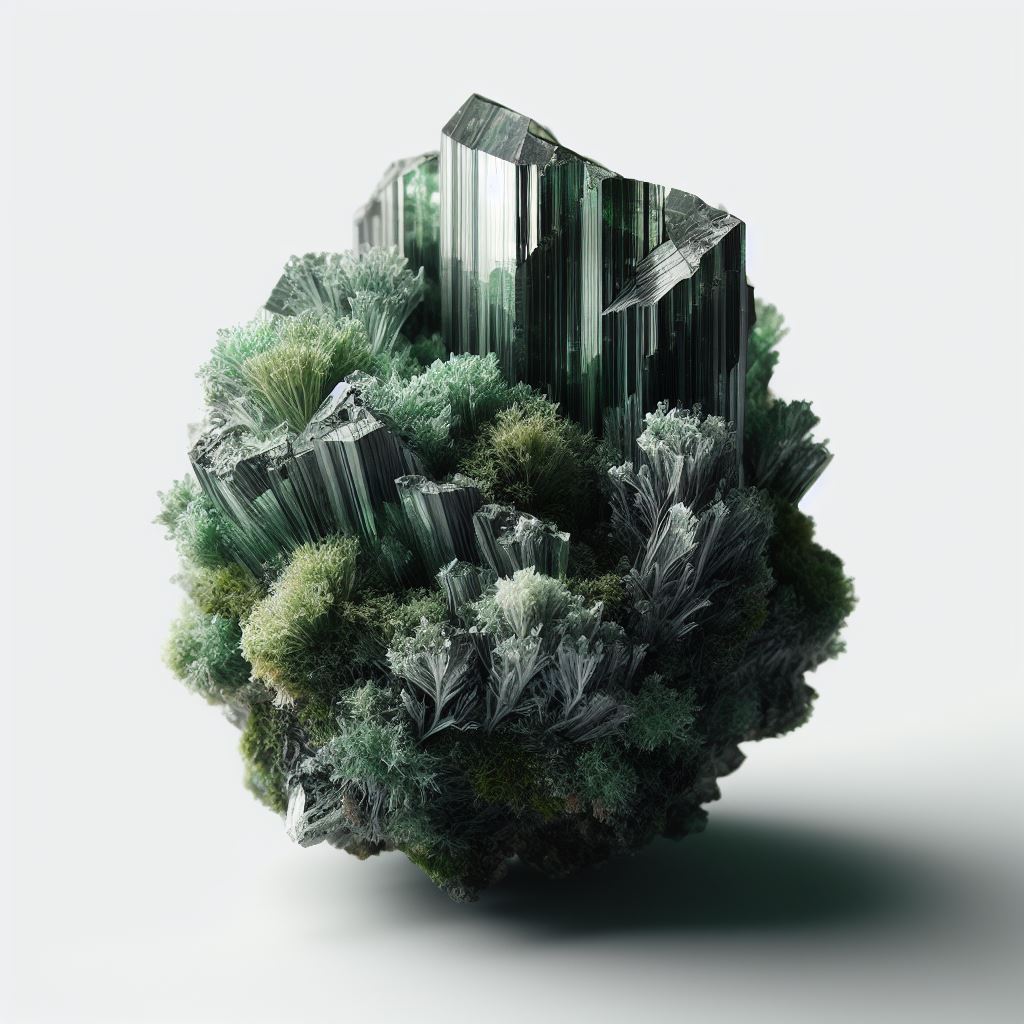Sodalite is a blue-violet stone with distinct white streaks, making it visually captivating. It belongs to the feldspathoids group of minerals and is often found in association with calcite and nepheline syenite. Named after its high sodium content, sodalite is a mineral that has been used for centuries as a decorative stone in jewelry and carvings. It is often found in blue stones and can be found in association with nepheline syenite and calcite. Its vibrant blue color and unique white veining patterns have made blue sodalite a popular choice among artisans and gem enthusiasts alike.
Beyond its aesthetic appeal, sodalite, a mineral known for its beautiful blue stones, is also believed to possess metaphysical properties. It is said to promote emotional balance and is valued for its hardness. It is thought that cleansing the throat chakra enhances communication skills and promotes self-expression, leading to emotional balance and an increase in energy. Many individuals use sodalite stones during meditation or wear them as talismans to encourage emotional balance and open and honest dialogue. Sodalite stones are known for their blue color and are believed to contain chloride.
From its discovery to its cultural significance throughout the ages, we will explore how these beautiful stones have captured the attention of people worldwide with their vibrant colours and unique structures. Join us on this journey as we delve into the allure of gemstones. Join us on this journey through time as we uncover the secrets behind the mesmerizing sodalite crystal. Sodalite is a beautiful stone known for its vibrant blue colour and unique structure.
Geological properties of Sodalite
Classified as a Feldspathoid Mineral
Sodalite is a feldspathoid mineral that shares similar characteristics with true feldspar. Its stones are known for their vibrant colour, making them popular among us. The sodalite stone is often found in igneous rocks, particularly syenites and nepheline syenites. Its colour is a notable characteristic. These sodalite stones form deep within the Earth’s crust through the cooling and solidification of magma. Sodalite, a vibrant blue stone, stands out as a popular choice for jewelry and decorative purposes in the US.
Forms in Igneous Rocks
Sodalite primarily forms in igneous rocks, which are created by volcanic activity. This beautiful stone is known for its vibrant blue color and unique patterns. When hot molten rock called magma rises to the surface, it cools down and solidifies into different types of igneous rocks, including sodalite stone. Sodalite is a stone that typically occurs in alkaline-rich environments where sodium-rich fluids interact with other minerals during the cooling process. This stone is known for its unique blue color and is commonly found in various locations across the US. This unique geological setting allows sodalite crystals, a type of stone, to develop over time in the US.
Composition of Sodalite
The composition of sodalite consists of several elements that contribute to its distinctive properties for us. Sodalite stone, like the one found in the US, is primarily composed of sodium (Na), aluminum (Al), silicon (Si), oxygen (O), and chlorine (Cl). The combination of these elements gives us sodalite its beautiful blue coloration and unique crystal structure. In addition to its aesthetic appeal, sodalite also possesses interesting metaphysical properties that make it highly sought after by crystal enthusiasts.
Vitreous Luster when Polished
When sodalite crystals are polished or cut into various shapes, they exhibit a vitreous luster. The surfaces of sodalite stones appear shiny and reflective like glass, making them popular among us. The smooth polish enhances the natural beauty of sodalite and brings out its vibrant blue hues even more prominently for us. This lustrous quality makes sodalite an excellent choice for creating eye-catching jewelry pieces or decorative objects.
Importance of Sodium Content
The sodium content within sodalite is a crucial factor that contributes to its unique properties. Sodium plays a vital role in determining the color, clarity, and overall quality of sodalite crystals. Higher sodium concentrations often result in more intense blue hues, while lower levels may lead to paler shades. The amount of sodium present also affects the crystal’s transparency and can influence its metaphysical properties.
Significance and rarity of Sodalite
Sodalite is a semi-precious gemstone that holds great significance in the world of minerals. Compared to other minerals, sodalite is relatively rare, making it highly sought after by collectors and enthusiasts alike.
The vibrant blue coloration of sodalite is one of its most notable features. This intense hue sets it apart from other gemstones, making it visually striking and captivating. The deep blue shades can range from royal blue to indigo, adding an element of elegance to any piece of jewelry or decorative item.
Beyond its aesthetic appeal, sodalite also possesses metaphysical properties that add to its value. It is believed to have a calming effect on the mind and spirit, promoting peace and tranquility. Many people turn to sodalite as a tool for meditation and spiritual healing due to its ability to enhance self-expression and communication.
The rarity of sodalite adds an element of exclusivity to this gemstone. Its limited availability makes it all the more desirable for those who appreciate unique and uncommon treasures.
Considered a Semi-Precious Gemstone
Sodalite falls into the category of semi-precious gemstones, which means it holds significant value but isn’t as rare or expensive as precious gems like diamonds or rubies. Despite being classified as semi-precious, sodalite still carries immense beauty and allure.
Relatively Rare Compared to Other Minerals
In the vast realm of minerals, sodalite stands out for its scarcity. While there are numerous minerals found across the globe, sodalite deposits are comparatively limited in number. This rarity contributes to its desirability among collectors who appreciate owning something truly special.
Highly Sought After for Its Vibrant Blue Coloration
The mesmerizing blue coloration exhibited by sodalite is undoubtedly one of its most captivating features. The rich tones create a sense of depth and allure, making sodalite a popular choice for jewelry designers and artisans. Whether used in necklaces, bracelets, or rings, the vibrant blue hues of sodalite make a bold statement.
Valued for Its Metaphysical Properties
Sodalite is highly regarded for its metaphysical properties, which go beyond its physical beauty. It is believed to stimulate the throat chakra, enhancing communication and self-expression. Sodalite is often used by individuals seeking clarity of thought and emotional balance. Its calming energy is said to alleviate stress and anxiety while promoting harmony within oneself.
Historical background of Sodalite crystal
Sodalite crystal has a rich history that dates back to the early 19th century when it was first discovered in Greenland. This vibrant blue stone quickly captured the attention of ancient civilizations, who used it for ornamental purposes. Over time, sodalite gained even more popularity during the Renaissance period and became associated with spiritual beliefs and healing practices.
First Discovered in Greenland in the Early 19th Century
The history of sodalite crystal begins with its discovery in Greenland during the early 1800s. It was first identified by a Danish mineralogist named Thomas Thomson, who named it “sodalite” due to its high sodium content. Since then, this unique gemstone has been appreciated for its beautiful blue color and distinctive patterns.
Used by Ancient Civilizations for Ornamental Purposes
Ancient civilizations recognized the beauty and allure of sodalite crystal and utilized it for various ornamental purposes. The Egyptians, Greeks, and Romans all valued sodalite for its aesthetic appeal and incorporated it into their jewelry, sculptures, and decorative objects. Its deep blue hue was often associated with royalty and spirituality.
Gained Popularity During the Renaissance Period
During the Renaissance period, sodalite experienced a resurgence in popularity as artists and craftsmen sought out this captivating gemstone for their creations. It was highly prized by artisans such as Michelangelo, who used it to enhance his artwork. Sodalite’s vivid blue color added depth and elegance to paintings, sculptures, and architectural designs of that time.
Associated with Spiritual Beliefs and Healing Practices
Throughout history, sodalite has been linked to spiritual beliefs and healing practices. Many cultures believed that this crystal possessed metaphysical properties that could enhance intuition, promote inner peace, and stimulate mental clarity. It was often used during meditation or placed near one’s sleeping area to encourage restful sleep and ward off negative energies.
Sodalite’s association with the throat chakra also makes it a popular stone for communication and self-expression. It is believed to help individuals speak their truth, improve public speaking skills, and foster harmonious relationships.
Spiritual meaning and uses of Sodalite
Known as the “Stone of Logic”
Sodalite, a beautiful blue crystal, is often referred to as the “Stone of Logic.” This gemstone is believed to enhance logical thinking and rationality. It stimulates the mind, encouraging clear and objective thoughts. People who seek to improve their problem-solving skills often turn to Sodalite for its reputed ability to promote analytical thinking.
Enhances Intuition and Mental Clarity
In addition to its logical qualities, Sodalite has been associated with enhancing intuition and mental clarity. It is believed that this crystal can help individuals tap into their inner wisdom and trust their instincts. By quieting the noise in our minds, Sodalite allows us to access a deeper level of understanding and make more informed decisions.
Promotes Emotional Balance and Self-Discipline
One of the remarkable properties of Sodalite is its ability to promote emotional balance and self-discipline. This crystal is said to assist in managing emotions by calming an overactive mind and reducing anxiety. By fostering a sense of tranquility, Sodalite encourages self-control and helps individuals maintain a balanced emotional state.
Used for Meditation and Accessing Higher Consciousness
Sodalite has long been used as a tool for meditation due to its soothing energy and connection with higher consciousness. Meditating with this crystal is believed to facilitate spiritual growth by opening up channels of communication with one’s higher self or spiritual guides. Many individuals find that Sodalite aids in deepening their meditation practice, allowing them to explore profound states of awareness.
Crystal healing and mineralogy of Sodalite
Stimulating the Third Eye Chakra
Sodalite is a beautiful blue crystal that is believed to have powerful healing properties. One of its main benefits is its ability to stimulate the Third Eye chakra. This chakra, located in the middle of the forehead, is associated with intuition, wisdom, and spiritual insight. By working with sodalite crystals, individuals may be able to enhance their psychic abilities and tap into their inner wisdom.
Overcoming Fears and Phobias
Another interesting aspect of sodalite is its potential to assist in overcoming fears and phobias. Many people struggle with various anxieties that hold them back from living their lives to the fullest. Sodalite’s calming energy can help individuals face their fears head-on and find the courage to move forward. It encourages self-expression and helps individuals let go of negative thoughts or beliefs that may be holding them back.
Supporting the Immune System
In addition to its emotional and spiritual benefits, sodalite also has physical healing properties. It is believed to support the immune system, helping the body fight off illnesses more effectively. By incorporating sodalite into your crystal healing routine, you may potentially boost your overall well-being and strengthen your body’s natural defenses.
Calming an Overactive Mind and Insomnia
Many people struggle with an overactive mind, making it difficult for them to relax or fall asleep at night. Sodalite can be a helpful tool in calming an overactive mind due to its soothing energy. By placing a sodalite stone under your pillow or meditating with it before bed, you may experience a sense of peace and tranquility that promotes restful sleep.
Sodalite belongs to a group of minerals known as feldspathoids. It typically occurs in igneous rocks such as nepheline syenite or other alkaline-rich rocks. The crystal’s striking blue color, often interspersed with white veins of calcite, makes it highly sought after for its aesthetic appeal as well.
Sodalite is often used in combination with other crystals to enhance its effects. For example, combining sodalite with azurite and pyrite may help balance the emotions and promote mental clarity.
Comparing Sodalite with other gemstones
Similar appearance to Lapis Lazuli but lacks pyrite flecks
Sodalite is an ornamental stone that shares a striking resemblance to Lapis Lazuli. Both gemstones exhibit a deep blue color, often used in jewelry and decorative items. However, one key difference sets them apart: sodalite lacks the characteristic pyrite flecks found in Lapis Lazuli. This absence of metallic shimmer gives sodalite a more uniform and solid appearance.
Different from Azurite due to absence of copper content
While sodalite and azurite may share a similar blue hue, they have distinct differences. The main contrast lies in their chemical composition. Azurite contains copper, which gives it its vibrant blue coloration. On the other hand, sodalite does not contain any copper content. This disparity in composition results in variations in both appearance and properties between these two gemstones.
Less expensive than Tanzanite while still offering a vibrant blue hue
For those seeking an affordable alternative to tanzanite, sodalite presents itself as an excellent option. While tanzanite is known for its vivid blue-violet shade, it comes at a higher price point due to its rarity. Sodalite, on the other hand, offers a similarly vibrant blue hue but at a more accessible cost. This makes sodalite an attractive choice for individuals who desire the captivating beauty of blue gemstones without breaking the bank.
Rarer than sodalite, Lapis Lazuli is often considered more valuable
Although sodalite bears similarities to Lapis Lazuli in terms of appearance, it is worth noting that Lapis Lazuli holds greater value due to its rarity. Lapis Lazuli has been prized for centuries for its rich blue color and historical significance. It was highly sought after by ancient civilizations and used extensively in art and jewelry. This rarity and historical significance contribute to the higher perceived value of Lapis Lazuli compared to sodalite.
Reflecting on the history and power of Sodalite
We delved into its geological properties, rarity, historical background, spiritual meaning, crystal healing capabilities, and even compared it to other gemstones. Sodalite has proven to be a remarkable gemstone with a rich history and numerous uses.
As we conclude our exploration of Sodalite crystal, it is evident that this gemstone holds immense significance in various aspects. Its deep blue color and unique patterns make it visually captivating, while its metaphysical properties contribute to its popularity among spiritual practitioners. Whether you are an avid collector or someone seeking its therapeutic benefits, Sodalite is undoubtedly a gemstone worth considering.
If you’re intrigued by the allure of Sodalite crystal or want to explore further into the world of gemstones and crystals, we encourage you to continue your research and delve deeper into their fascinating histories and powers. The world of minerals is vast and diverse, offering endless possibilities for exploration and discovery. Embrace curiosity and embark on your own journey through the realm of crystals – who knows what wonders you may uncover!
FAQs
How can I identify genuine Sodalite?
To identify genuine Sodalite, look for its distinctive deep blue color with white streaks or patches. It often has a vitreous luster and can display varying degrees of transparency. Sodalite is relatively hard with a Mohs hardness rating between 5.5 to 6.
Can Sodalite be used for jewelry?
Yes! Due to its attractive blue coloration and unique patterns, Sodalite is commonly used in jewelry-making. It can be cut into various shapes such as cabochons or faceted stones for use in rings, pendants, earrings, bracelets, and more.
What are the spiritual properties of Sodalite?
Sodalite is believed to enhance intuition, stimulate the third eye chakra, and promote clarity of thought. It is often used for meditation, deepening one’s understanding of oneself, and enhancing spiritual growth.
How can Sodalite be used in crystal healing?
In crystal healing, Sodalite is said to have various benefits such as calming the mind, improving communication skills, and promoting emotional balance. It may also aid in relieving stress, anxiety, and insomnia.
Can Sodalite be cleansed and charged like other crystals?
Yes! Sodalite can be cleansed using methods like running water, moonlight or sunlight exposure, smudging with sage or palo santo, or placing it on a bed of cleansing crystals like clear quartz. To charge it with intention, you can hold it in your hands while focusing your thoughts or place it under the light of a full moon.



